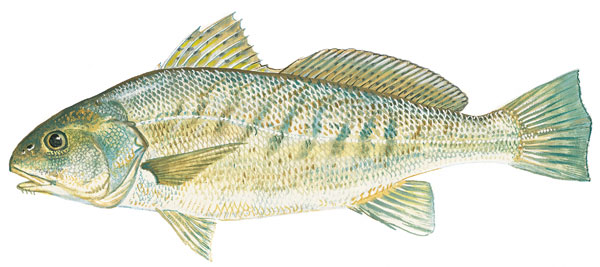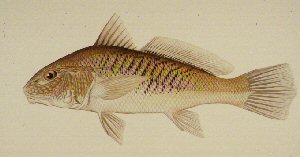Atlantic croaker
Atlantic croaker ( Micropogonias undulatus)
The Atlantic croaker (Atlantic croaker, Micropogonias undulatus ) is a species of the genus Micropogonias from the east coast of North America. Characterized by it's (about 5 ) very small ( short ) barbels ( Hautläppchen ) on the lower jaw edge. He sensed, floating in groups, his prey animals from mud and detritus fine sand areas off the coasts: worms, mollusks, crabs ( of course free floating ), also fish and algae.
Description
The Atlantic croaker can be 55 cm long, 2,6 kg and 5 years old. Its hull is almost spindle-shaped, pink -beige colored, marked with dark, wavy arranged spots. Because of this wave-like drawing of the Atlantic croaker got his epithet undulatus ( waved ). The caudal fin is almost straight cut at the trailing edge.
Fins formula: Dorsal D1 X -XI, D2 I / ~ 30, Anal AII/9-11.
Dissemination and lifestyle
It is spread out from Massachusetts to the south, also in the Gulf of Mexico to northern Mexico, but missing to Florida. Deposits to the south of the Lesser Antilles to Brazil and Argentina are unclear. It is possible that in sporadic finds a different kind, Micropogonias furnieri. The genus Micropogonias occurs with six species in the eastern Pacific.
The Atlantic croaker is one of the best-studied East Coast Umbern (about 23 species ) - but much is still unclear. It spawns ( in large quantities) in the open water, up to 70 km off the coast, usually in the fall. With the spread of larvae by ocean currents, the season in which the eggs are released in large numbers into the free water plays a major role. The young fish are imperiled in the rise in cold water incursions. In addition, the Atlantic croaker was as accidental bycatch often decimated so that its fishing results are declining. It is important, as with many Umbern that the larvae and juveniles in waters of lower salinity ( brackish water) can grow. The larvae can be worn by near-surface currents near the coast. General environmental stress leads to bacterial diseases. Nevertheless, the Atlantic croaker is still an important economic fish; also for the sport of fishing it is of great importance, especially as it is considered very tasty and can be cooked in various ways.
According to Production: Gannon (2007) showed that this Umber sounds generated not only when spawning foreplay and while capturing becoming ( in stress), but also as Fühlungs funds (own " clicks" that are typical for the age of the animals).
In the Netherlands, he recently received a vernacular names ( " Knorr epos " = ' growls ruffe ') - because he repeated in Belgian- Dutch About. Has emerged coastal waters (after involuntary passage in ballast water). The genus name is a little accident, as Cuvier in 1830 wanted to call the fish shown above " Micropogon " (little bit); but this name was already taken to a Barbet, so that Bonaparte 1831, simply by adding the ending - ias (as in Pogonias ) behalf.









